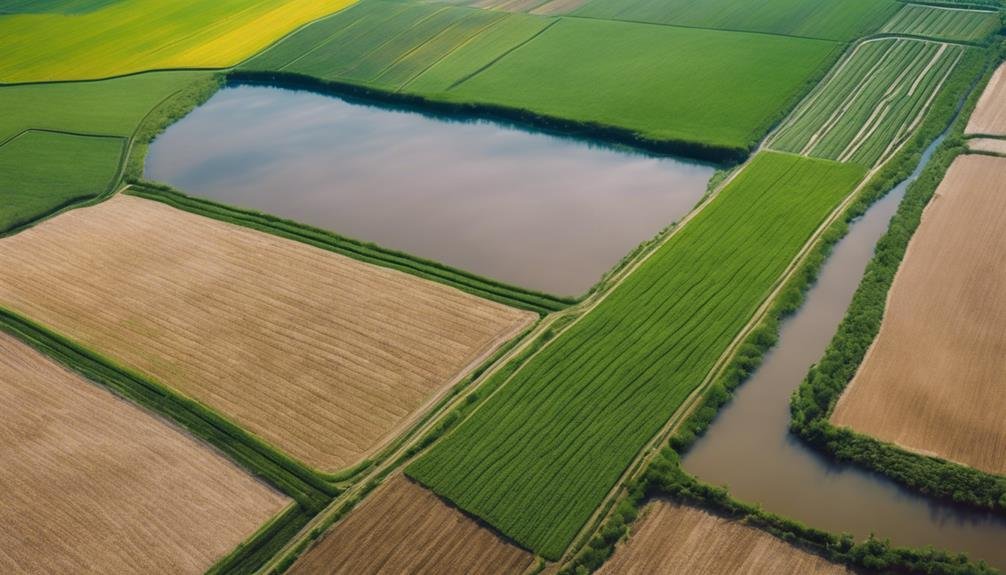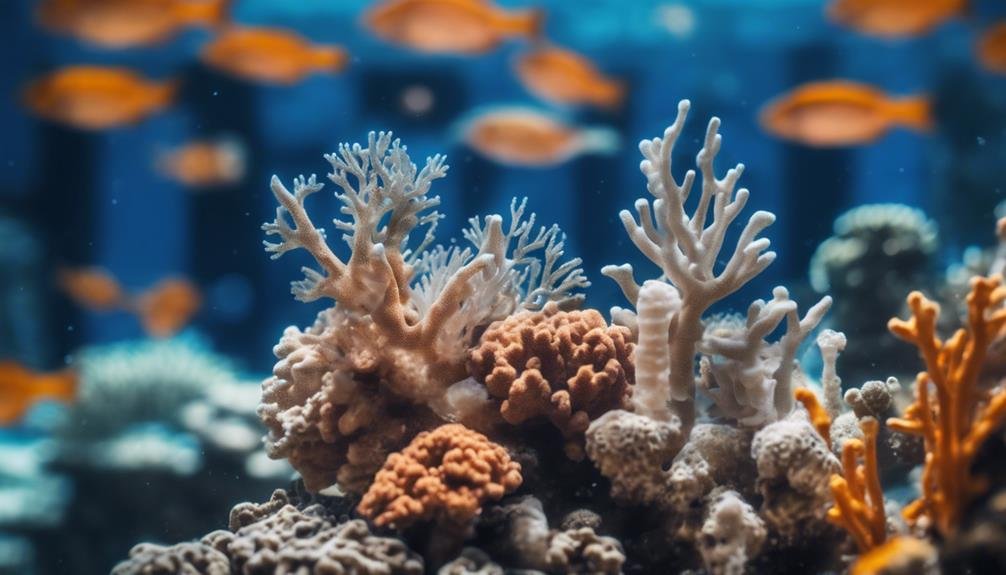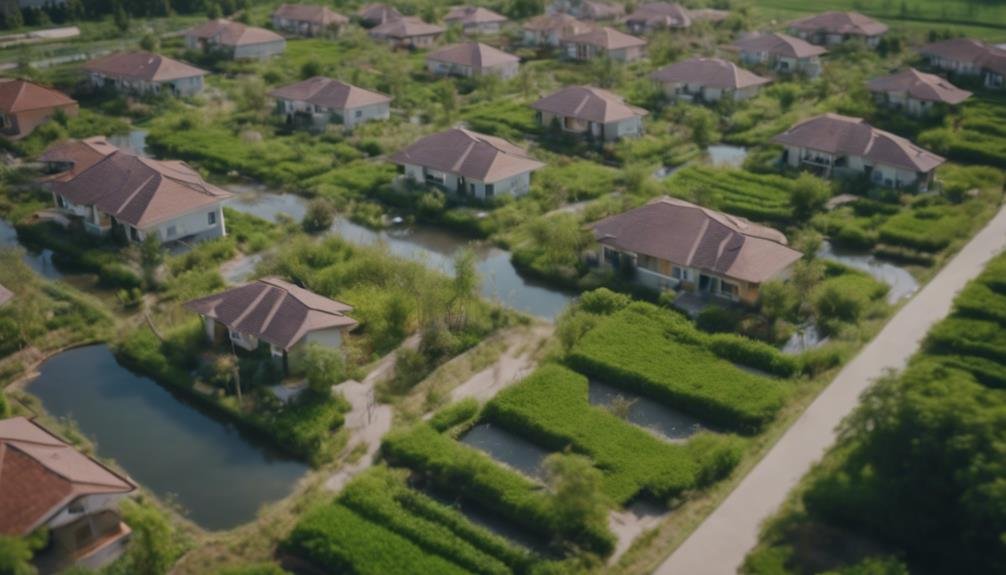To solve common water quality problems, you'll need a multi-faceted approach. Start by identifying issues through regular testing. Install filtration systems to remove contaminants and use water softeners if necessary. Implement wastewater treatment technologies like sedimentation, filtration, and disinfection. Prevent agricultural runoff with buffer zones and cover crops. Manage urban stormwater using rain gardens and permeable pavement. Address ocean acidification by reducing carbon emissions. Conserve water in your home and garden with efficient appliances and smart irrigation. Proper maintenance of plumbing systems is essential. By combining these strategies, you can effectively tackle various water quality challenges and protect this essential resource.
Some of the links in this article may be affiliate links. If you make a purchase through these links, we may earn a small commission at no extra cost to you. Thank you.
Identifying Common Water Quality Issues
Water quality issues can sneak up on you, so it's important to know what to look for when evaluating your water supply. Common water quality problems often stem from contamination caused by various sources of water pollution. These can include industrial waste and stormwater runoff, which introduce harmful pollutants and chemicals into water sources.
To identify potential issues, you'll need to monitor several water quality parameters. These include factors like pH levels, turbidity, and the presence of specific contaminants. Water testing services, such as those offered by Five Star Home Services, can help you detect these problems accurately.
It's essential to be aware of the signs of poor water quality, as it can lead to serious health problems and ecosystem damage. Some indicators may include unusual taste, odor, or color in your water. However, many contaminants aren't detectable without proper testing.
Wastewater Treatment Technologies
To effectively tackle water quality problems, you'll need to understand the array of wastewater treatment technologies available today. These technologies are vital in removing pollutants from sewage and industrial wastewater, helping to protect water quality and prevent waterborne diseases. They employ physical, chemical, and biological processes to reduce contaminants like organic matter, nutrients, pathogens, and toxic substances.
Common wastewater treatment methods include:
- Sedimentation: Allows solid particles to settle out of water
- Filtration: Removes particles by passing water through various media
- Disinfection: Kills harmful microorganisms
- Advanced processes: Such as membrane filtration and reverse osmosis
These technologies work together to ensure that wastewater can be safely reintroduced into the environment or reused for irrigation or industrial processes.
By effectively treating wastewater, you're not only addressing immediate water quality issues but also preserving aquatic ecosystems for the long term.
Understanding these treatment methods is essential for anyone dealing with water quality problems. They form the backbone of our efforts to maintain clean water sources and protect both human health and the environment.
As water scarcity becomes more prevalent, the importance of efficient wastewater treatment will only continue to grow.
Agricultural Runoff Prevention Strategies

While wastewater treatment is essential for urban areas, preventing agricultural runoff is equally vital for maintaining water quality in rural regions. To tackle this issue, you can implement several effective strategies.
First, consider creating buffer zones and vegetative strips along water bodies. These natural barriers help reduce sediment and pollutants from entering water sources.
Additionally, you'll want to use cover crops like legumes and grasses, which absorb excess nutrients and prevent them from leaching into nearby water bodies.
Precision agriculture techniques can greatly reduce runoff by applying fertilizers and pesticides more efficiently. You'll also benefit from sustainable farming practices such as crop rotation and reduced tillage, which improve soil health and decrease erosion.
Another effective approach is to utilize controlled drainage systems and constructed wetlands. These systems capture and treat agricultural runoff, enhancing water quality in surrounding areas.
Urban Stormwater Management Solutions
When it comes to tackling water quality issues in cities, you'll need to focus on effective urban stormwater management solutions. Stormwater runoff in urban areas can carry pollutants into water bodies, making it important to implement strategies that reduce this pollution.
Green infrastructure practices play a significant role in managing stormwater by absorbing and filtering runoff.
Here are some key urban stormwater management solutions:
- Rain gardens and permeable pavement to increase water absorption
- Detention ponds and bioswales to slow down and treat runoff
- Green roofs to capture rainwater on building surfaces
- Rain barrels to collect and reuse stormwater
These solutions help protect water quality and prevent flooding in urban environments. By implementing a combination of these strategies, you can effectively manage stormwater runoff.
Detention ponds and bioswales work by temporarily holding water and allowing it to slowly infiltrate the ground or evaporate. Green roofs not only capture rainwater but also provide insulation and reduce the urban heat island effect. Rain barrels offer a simple way to collect and reuse stormwater for activities like watering gardens.
Addressing Ocean Acidification

Ocean acidification's a significant threat to marine ecosystems that you can't afford to ignore. It's primarily caused by the absorption of excess carbon dioxide from the atmosphere, leading to a decrease in seawater pH levels. This process poses significant risks to marine life, particularly shellfish and coral reefs, as it hinders their ability to form calcium carbonate structures essential for their survival.
The impacts of ocean acidification extend beyond individual species, disrupting entire marine ecosystems and affecting food chains and biodiversity. To address this issue, you need to focus on reducing carbon emissions and implementing sustainable practices to protect marine environments. It's essential to monitor pH levels in the ocean to understand the extent of acidification and implement effective conservation measures.
You can contribute to solving this problem by supporting initiatives that aim to reduce carbon emissions, promote sustainable fishing practices, and protect coastal habitats. Additionally, staying informed about ocean acidification and its impacts can help you make environmentally conscious decisions in your daily life.
Reducing Plastic Marine Pollution
In light of the staggering amount of plastic entering our oceans each year, you've got to take action to reduce plastic marine pollution. The impact of plastic waste on marine ecosystems is severe, affecting over 700 species through ingestion or entanglement.
To combat this issue, you can:
- Opt for reusable items instead of single-use plastics
- Recycle plastic properly
- Participate in beach clean-ups
- Support innovative solutions like biodegradable plastics
By making these changes, you'll help protect marine life and human health. Contaminated seafood is a direct consequence of plastic pollution, affecting your well-being. Improved waste management systems are critical in addressing this problem on a larger scale.
To effectively reduce plastic marine pollution, understanding the scope of the issue is vital. Approximately 8 million tons of plastic enter the ocean annually, causing widespread damage. By choosing reusable items and recycling, you're taking important steps to mitigate this problem.
Additionally, supporting research and development of biodegradable plastics can lead to long-term solutions. Remember, your actions matter in the fight against plastic pollution and the preservation of our oceans.
Water Conservation Techniques

Water conservation is an essential step you can take to protect this precious resource and reduce your environmental impact. As water is a scarce resource, it's important to implement conservation techniques in your daily life.
One of the simplest methods is turning off taps when they're not in use, preventing unnecessary water wastage. You can also make a significant difference by shortening your showers or baths, which can substantially reduce your daily water usage and contribute to overall conservation efforts.
When it comes to outdoor activities, use only the necessary water for gardening and other tasks. This approach helps conserve water resources and maintains a balance between human needs and environmental preservation.
Inside your home, consider installing efficient toilets that use less water per flush. Ultra-efficient models using just 0.8-1.1 gallons can help you save both water and money in the long run.
Frequently Asked Questions
How Can We Solve Bad Water Quality?
To solve bad water quality, you'll want to implement treatment systems like reverse osmosis or UV purification. Regularly test your water, address specific issues, and consider installing softeners or filters. Don't hesitate to seek professional advice when needed.
What Are 5 Actions We Can Do to Improve Water Quality?
You can enhance water quality by implementing treatment systems, regularly testing water sources, promoting green agriculture, educating communities on proper waste disposal, and supporting protective legislation. These actions will help guarantee cleaner, safer water for everyone.
What Is the Most Common Problem of Water Quality?
The most common water quality problem you'll face is hard water. It's caused by high levels of calcium and magnesium. You'll notice it affects your appliances, leaves residue, and can make soap less effective.
What Are 10 Ways to Reduce Water Pollution?
You can reduce water pollution by recycling, using eco-friendly products, conserving water, practicing green agriculture, managing stormwater, treating wastewater, avoiding chemical fertilizers, properly disposing of medications, participating in clean-up events, and educating others about water conservation.
Conclusion
You've now explored key strategies for addressing water quality challenges. By implementing these approaches, you'll be taking steps to improve our aquatic environments.
Remember, every effort counts, from reducing your personal water usage to supporting larger-scale initiatives. While the task may seem intimidating, with collective action, we can make significant progress.
Your continued awareness and involvement are essential for safeguarding our precious water resources for future generations.

